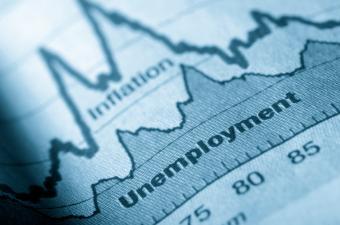The nation's economy added 162,000 jobs in July as the unemployment rate fell to 7.4.percent, the ""Bureau of Labor Statistics"":http://www.bls.gov/news.release/archives/empsit_08022013.pdf (BLS) reported Friday. Economists had forecast payrolls would grow by 175,000 and that the unemployment rate would dip to 7.5 percent.
[IMAGE]Payroll growth for June, originally reported at 195,000, was revised to 188,000. May payroll growth was revised to 176,000 from 195,000.
Average weekly hours fell to 34.4, compared with forecasts of 34.5, and average hourly earnings fell two cents.
Despite the increase in jobs, the report could have a major negative impact on the broader economy, as it showed more people with jobs but working fewer hours and for less money. Aggregate earnings (jobs multiplied by hours multiplied by average hourly earnings) fell about $286 million in July. Year-over-year, aggregate earnings are up 3.6 percent down from the 4.2 percent growth in June.
Indeed, the reduction in average hours was the equivalent of a cut in jobs: Aggregate hours, obtained by multiplying jobs by average weekly hours, fell about 8 million from June. If the average work week had remained at 34.5 hours, it would have required 232,000 fewer jobs.
The improvement in the unemployment rate came largely from a drop in the labor force, which fell 37,000 in July. The number of persons not in the labor force--which would include individuals who are no longer looking for work and not counted as unemployed--fell 240,000. The labor force participation rate dropped to 63.4--matching May--from 63.5 percent in June. The participation rate was 66.0 percent when the recession began in December 2007.
The broader employment-population ratio, which measures employment against the total population (irrespective of availability for work) remained at 58.7 percent. The ratio was 62.7 percent when the recession began.
The number of persons employed--drawn from a household survey conducted by the Census Bureau--increased 227,000 in July, and the number of persons unemployed dropped 263,000 to 11,514,000, the lowest level since December 2008.
Long term unemployment --greater than 26 weeks--dropped 82,000 to 4,246,000.
The increase in jobs in July marked the 34th straight month in which payrolls have gone up. Private sector payrolls increased 161,000--the 41st straight month private sector jobs have improved.
The increases, though, were tempered by revisions to May and June, a net decline of 26,000 jobs compared with previous reports. In the last three months, payrolls have increased an average of 175,000, down from the 215,000 average for the previous six months.
The report showed a month-over-month increase of 6,000 manufacturing jobs--the first since February--fueled by an increase of 9,100 automobile industry jobs.
The number of construction jobs fell 6,000 in June though residential construction jobs rose 6,300 reflecting burgeoning builder confidence.
By industry sector, jobs gains were led by an increase of 46,800 retail jobs in July on the heels of 32,600 more retail jobs in May and 39,700 in June.
The number of leisure and hospitality jobs grew 23,000 in July after increasing 43,000 in May and 57,000 in June. The two sectors have accounted for 46 percent of all new jobs in the last three months.
The gain in the leisure and hospitality sector came in restaurant jobs, which increased 38,400, overcoming a drop of 10,200 arts and entertainment jobs and 5,300 hotel jobs.
The leisure and hospitality and retail sectors are the lowest-paying industry groups, with average weekly earnings of $349.13 and $520.61, respectively. Average weekly earnings for all sectors in July, according to BLS, were $824.91.
The number of temporary jobs increased 7,700 compared with an average monthly increase of 21,500 in May and June. Temporary jobs are thought to be an indicator of broader employment increases but could also signal waning confidence among employers reluctant to make permanent staff additions.
The financial sector added 15,000 jobs in July, up from the average of 10,000 for May and June. New financial jobs included 3,600 underwriters and 3,000 new real estate jobs, reflecting the uptick in home sales.
The number of multiple jobholders dropped 29,000 while the number of self-employed increased 241,000 in July. Self-employed individuals are not included in the payroll job count.
The jobs report took on added significance as traders and investors look for a signal that the Federal Reserve would cut back on its purchase of mortgage-backed and Treasury securities in its program to expand the nation's money supply in an effort to revive a still-lagging economy. The Fed has been purchasing $85 billion of the securities each month but indicated it would taper that program as employment improved and inflation remained under control.
The Fed set a target of a 6.5 percent unemployment rate to reverse its easing of monetary policy and an inflation rate of 2 percent.
The number of government workers increased a net 1,000 in July; the number of local government jobs grew 6,000, but the number of state government jobs dropped 3,000, and the number of federal jobs was down 2,000.
The education and health care sector added 13,000 jobs, down from the three-month average of 16,000 new jobs per month in that sector.
With the increase in jobs, the number of ""discouraged"" workers fell to 988,000 in July from 1,027,000 in June but was up 136,000 from a year earlier. The number of re-entrants to the labor force--individuals previously unemployed who resumed a job search--fell 32,000 in July to 3,258,000.
The number of job ""losers"" dropped 198,000 in July to 6,119,000, the lowest level since September 2008, suggesting businesses have stopped large-scale layoffs, as the trend in initial unemployment claims indicates. The number of ""new entrants"" to the unemployment rolls fell 5,000 in July, suggesting recent graduates were able to find work or have opted to continue their education.
_Hear Mark Lieberman on P.O.T.U.S. Radio, Sirius-XM 124, next Friday at 6:20 a.m. Eastern._

 theMReport.com Your trusted source for mortgage banking news
theMReport.com Your trusted source for mortgage banking news









